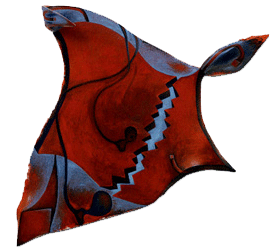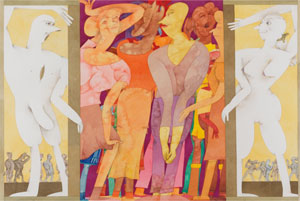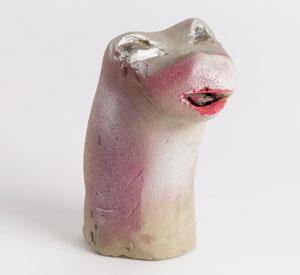When Women Kept Painting
John Haberin New York City
Elizabeth Murray: Drawings
Gladys Nilsson and Marisa Merz
Did it take a woman to guide painting through the 1980s? Elizabeth Murray did so more than anyone, when so many had given up on it entirely. She also did as much as anyone to guide it through debates among painters, then and now.
Had Pop Art sold out, or did it underlie the fresh vitality of "new image" painting, "pattern and decoration," political art, and more all along? It took a mature painter to find her way through it all—possibly the very best painter around. So surprise: a focus on Murray's drawings begins with her as a child. Meanwhile Gladys Nilsson on paper stayed closer to her roots, too, in Chicago, Pop Art, Surrealism, and the battle of the sexes. Meanwhile Marisa Merz, the only woman in Arte Povera, puts the men to shame. 
Merz started out working in her kitchen, on the way to a retrospective at the Met Breuer. It could have come sooner, but never mind. Women often earn less than their share, in both money and recognition. If Arte Povera means poor art, does that make Merz the poorest of the poor? Others often treated her that way, but she proves otherwise, from the coarse grandeur of her early sculpture to increasingly ethereal images of women. Along the way she brought to the Italian art movement something it dearly lacked—humor and introspection.
Portrait of the artist as a little girl
"I remember thinking, wow, that is so incredible." Not every exhibition begins with an artist's student work, much less in nursery school. Carroll Dunham and Dan Nadel introduce Elizabeth Murray by quoting some of her earliest memories. She describes herself as a little girl, as a teacher sits her down, sets red crayon to paper, and insists that she does, too. It opens everything for her, taking her into territory that she knows must be her own. It also proves a challenge, but she is in it for the long haul.
Her forty drawings (and a painting) date from Murray's maturity in the 1980s and 1990s. She had moved to New York in 1967, still in her twenties, and she was working alongside artists like Brice Marden and Robert Ryman who kept painting alive through Minimalism and beyond, when right-thinking people deemed it dead. Yet she and other women in postwar abstraction were also exploding painting, with divided and shaped canvas that could make Frank Stella seem all the more prescient—or downright tame by comparison. She was bridging gestural abstraction and imagery, too, like Susan Rothenberg. She might resent being pigeonholed as a woman with teacups, but art, feminism, and everyday life for her belonged together. Dunham and Nadel, though, start the story earlier.
They stress her roots in Chicago, at the Art Institute and Mills College. They compare her to artists there obsessed with cartoons, like Robert Arneson and the Hairy Who in her native city, Chicago. And, yes, they quote her account of her origins. Maybe it takes gumption then to insist that she belongs to no school, not even a literal one. Maybe, too, no one can remember much from age three, at least reliably. Still, they want to see her as impulsive, childlike, a little smug, anxious, and eclectic.
In other words, they see her as rather like them. (Nadel has published Dunham's drawings, too.) As curators, they divide Murray's into mere notes, studies, presentation drawings, and work for Travel and Leisure magazine. They find her at her least shaped and structured, including life forms with more limbs than I can count. They show her working toward paintings with such crazed titles as Tangled and Yipes. They show her, too, at ease with landscape and commercial art.
They miss out on the power of MoMA's Elizabeth Murray retrospective, opened just two years before her death in 2007. They do, though, insist on her as postmodern and relevant. Now she fits right in even on the Lower East Side. She shares the gallery with Marcus Jahmal, still in his twenties. In his interiors, an overhead light can look like a shower and a painting like a window onto outer space. Walls can come together at all the wrong places, while a planet much like his own can hurtle past.
It makes for a reasonably promising beginning, but then so does Murray as a girl. She is revealing by her sheer unreliability as a narrator. Sigmund Freud spoke of screen memories of early childhood—meaning adult constructions with grown-up consequences. Here her teacher pushes the crayon to the edge of the paper, she recalls, just as she will use canvas to outline an image. She will also push paint to warm colors, broken patterns, and protruding edges. Shaped canvas becomes a metaphor for lives coming together or coming apart.
Sex in Chicago
Gladys Nilsson takes as her subject the battle of the sexes. It is not going well for the men. Oh, sure, it is all in fun—maybe especially when the women manhandle them. They may even like it when a woman steals their beach towel. They can always take refuge with the throng of smaller figures between and around the playful warriors, in what I hesitate to call the foreground or background. At least those characters get to keep their clothes on.
 The sexes may meet as equals, like teams of construction workers at left and right of Léger Faire. A man and women, both naked and both in white, flank a central grouping in a more colorful shallow space. The twin attendants could be drawing apart the doors to reveal them, like angels parting the curtain for a Renaissance Madonna by Piero della Francesca. Then again, the two could be closing the doors on an overcrowded elevator, like subway packers in Japan. (To help you decide, Nilsson titles the scene Caught—with maybe an added gotcha at the viewer.) Still, for all the fun and fair game, no question but women get the better deal.
The sexes may meet as equals, like teams of construction workers at left and right of Léger Faire. A man and women, both naked and both in white, flank a central grouping in a more colorful shallow space. The twin attendants could be drawing apart the doors to reveal them, like angels parting the curtain for a Renaissance Madonna by Piero della Francesca. Then again, the two could be closing the doors on an overcrowded elevator, like subway packers in Japan. (To help you decide, Nilsson titles the scene Caught—with maybe an added gotcha at the viewer.) Still, for all the fun and fair game, no question but women get the better deal.
They get to smile, wave, and strut their stuff, in light or sheer clothing, even if one woman's rear end faces forward—unless, of course, her breasts have cloned themselves and migrated downward. Meanwhile the men have it more figuratively ass backward. They wear uniformly grim expressions, to go with their stiff, limp, or hairless bodies. They sport oversized penises with nowhere to go but up. Maybe they are just getting what they deserve. Maybe, too, they will learn any minute to take equal pleasure in the raucous play.
The large watercolors date from the mid-1980s, but they could almost belong to an earlier and less anxious America. They show little of the politics of the AIDS crisis, "Off the Record," or "Pictures generation," give or take the sex. The strutting recalls Reginald Marsh, Paul Cadmus on Coney Island, and American Surrealism. The construction sites recall workers taking lunch on a beam of the future Rockefeller Center, in a photograph no longer attributed to Lewis Hine. The stacked and tilted tiers recall Cubism, much as the robust colliding figures recall Fernand Léger—but with pointy noses out of a New Yorker cartoon. Nilsson's titles run to gentle puns reminiscent of gentler times.
Then, too, they could just stem from a gentler art scene. Nilsson had a solo show at the Whitney in the 1970s, but her life and career belong to the Chicago area. Born in 1940, she attended the School of the University of Chicago and exhibited with the Hairy Who. She married Jim Nutt—who does to Picasso's women what Nilsson does to Léger. Her skill and lightness contrast with Nutt's bluntness and the agonized expressions of a third Chicago Imagist, Karl Wirsum. She long exhibited at Phyllis Kind but remains little known in New York.
Those gentler times could also start to look very much like the present, whether I like it or not. Caricature, graphic novels, their lack of subtlety, and their horror of the vacuum have entered the mainstream. Robert Crumb and Roz Chast have exhibited in Chelsea galleries. Nillson took up watercolors to avoid paint fumes during pregnancy, but she has made them her own. The large format gains from torn edges and the grain of the paper. Her fantasies may yet come true.
Out of the kitchen
Marisa Merz outgrew the kitchen almost before she began, and she made art out of that, too. Others in Arte Povera were out to bring art down a notch, if not Giuseppe Penone, but with an unwavering solemnity befitting a higher calling. Alighiero Boetti did it by refusing to call his tapestries and monuments art objects—and Lucio Fontana by taking a knife to his canvas, like a tasteful act of murder. Merz's husband, Mario (who died in 2003), made still life from real fruit, as if nothing less would provide nutrition for body and soul. Marisa found room in the kitchen for more, starting with her towering Living Sculpture from the mid-1960s. It brought a car wreck to sculpture, like John Chamberlain or Lynda Benglis in America, but with every sign of life.
Her massive aluminum, plain or with spray paint, can take the shape of an overstuffed armchair, a marionette or a monster, a forest canopy, or a doghouse. It looks even funnier in a photo, suspended over the stove of her cluttered apartment. It was not her last foray into shiny objects or homemaking either. She soon turned to woven grids of copper wire, inspired in part by knitting with her daughter—whose name she fashions in nylon thread. They build on small squares with concave sides, like potholders, but they grow quickly. The tacks holding them to the wall can spin off to complete an otherwise empty grid of their own, in much the same bright coppery hue. 
Merz makes reconstructing her career difficult, even for the curators, Connie Butler of the Hammer Museum and Ian Alteveer of the Met. She reuses materials, repurposes older work, and leaves much of it undated and untitled, but allow me to help. Born as early as 1926 (depending on whom and when you ask), she took up wire in the mid-1970s, along with her first images of women. They include her first Teste, or heads, in wax and unfired clay. By the 1980s, they also include the graphite swirls of what could well be self-portraits, archetypes, or angels. Already she sacrifices some crudeness and comedy in search of a woman's art.
They, too, start small but keep growing in scale and ambition—quite from the show's cheesy title, from a poem of hers, "The Sky Is a Great Place." They also leave ambiguous the line between a woman's self-assertion and a woman acted on. In graphite, her subjects can seem thoughtful or otherworldly. By the 1990s they have taken on pastel, gold leaf, and hints of the Virgin Mary as a queen of the heavens. One of the latest and largest rests against the wall behind huge timbers. The wires grow, too, in the 1990s, coiling more tightly, staking out large triangles on the wall, or resting casually as what Merz calls scarpette (or small shoes) but look more house slippers.
She is stepping out, in comfort, but still at home. It appears in indoor fountains, one shaped like an earthen square from an ancient culture, another like a violin in wax. It appears most of all, though, in her sculpture. The heads may seem boastful or damaged, with the imprint of her hand and splotches of color like lipstick or blood. They may seem broken off from a more heroic or feminine body. They may share a steel table with one another or a tablecloth in lead.
Merz retains a sense of damage or incompletion from Arte Povera. One work consists simply of taped lines on a broken mirror, while others incorporate a binder clip, torn flowers, plastic caps, and a paint can. Both wire patterns and gray swirls may follow the Fibonacci series, an interest of Mario Merz and Renaissance mathematicians as well. The heads have ancestors in wax sculpture from an earlier Modernism by Medardo Rosso, too. The grandeur may become forced, cryptic, or self-defeating, like a painting that alludes to Ben-Hur. Never doubt, though, that this woman's sculptures are alive.

Elizabeth Murray drawings ran at Canada through January 29, 2017, Gladys Nilsson at Garth Greenan through February 18, and Marisa Merz at the Met Breuer through May 7. A related review looks in more depth at Murray, thanks to her late work and 2005 retrospective.




